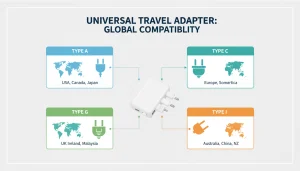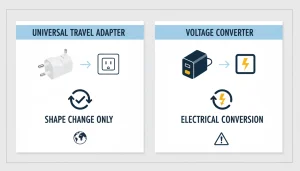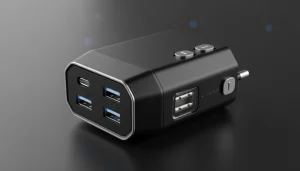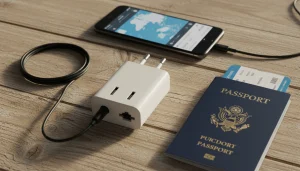The scene is always the same. I arrive after a grueling trip, ready to unwind, and immediately try to charge my phone. That’s when I remember the tiny, frustrating detail: the wall socket is a shape I don’t recognize. The flat prongs from my home charger are utterly useless against the round holes staring back at me. I’ve spent too many frantic hours hunting for the right connector shape, feeling completely disconnected and powerless.
That feeling is exactly why my essential travel item isn’t my passport, but my universal travel accessory. It’s the single best piece of equipment I own for international charging. This compact component allows any standard connector (like the one for your phone or laptop charger) to fit safely and instantly into the wall sockets found across nearly the entire globe. It doesn’t change the electric current, but it’s the physical key that unlocks electricity anywhere. Over the years, I’ve used these devices everywhere from a bustling Hong Kong high-rise to a remote cottage in the Scottish Highlands. The ability to charge without worry is priceless.
My personal guide will show you exactly what this device is, how I use it to keep all my gadgets ali
ve, and the critical safety mistakes you need to avoid when you use it.
Pinpointed Topics You Will Master in This Guide:
- Why is this component the one item I always pack first?
- The difference between a travel accessory and a voltage converter (a mistake that can fry your hairdryer).
- My non-negotiable checklist for the best power features in 2025.
- A comprehensive breakdown of the world’s major connector types and where they’re used.
- Real-life travel scenarios where my trusty helper saved the day.
- Safety rules I follow when connecting to foreign current sources.
The Core Function: How My Accessory Actually Works
I often hear people call this device a magic box, but it’s really just clever engineering. The entire purpose of this essential travel gear is to solve the “connector shape problem.”
The truth is, the world is divided into at least 14 different standard socket styles. These range from the flat, parallel prongs in North America (Type A/B) to the three massive, rectangular blades you find in the UK (Type G). Trying to match every single one with individual adapters is a nightmare. I’d need a dedicated bag just for these components!
Mechanical Adaptation, Not Electrical Change

Here is the most important lesson I’ve learned about this device: It only changes the shape. I like to think of it as a physical key to a lock. If your home key is rectangular and the new country uses a round keyhole, the device simply gives your rectangular key a round shape on the outside. It never messes with the electricity flowing through the wires.
The mechanics inside my compact accessory are brilliant. It features a mechanism—usually a sliding or retractable system—that allows me to deploy the correct set of prongs for the region I’m in. Say I land in Paris: I slide a switch, and the two round, slim prongs for Europe (Type C/F) pop out. A moment later, I’m in Sydney, I slide the switch again, and the angled flat prongs (Type I) appear. The beauty is that the other prongs remain safely locked inside the item until I need them. This single action is what makes it universally compatible.
The outer side of the item is a universal socket faceplate. This is the opening where I connect my phone charger or laptop cable from home. It’s cleverly designed with multiple slots and holes to accept almost any connector shape from any country. This means my US-style laptop charger can connect to this accessory, and the accessory itself can then connect to a Type G (UK) wall socket, solving the physical mismatch instantly.
My favorite models also include a locking feature. When I push the correct prongs out, they click firmly into place. This is a small detail, but a major sanity saver. Nothing is worse than an international adaptor that keeps slowly retreating into the body of the device while I’m trying to charge, especially when I’m leaning on it for a midnight charge. This locking mechanism keeps the connection secure, steady, and safe.
The simple, mechanical function is what makes this small component so effective. It removes one of the biggest headaches of international movement without introducing electrical complications. It’s reliable, predictable, and doesn’t require me to carry heavy, complex parts. It just works.
Beyond the Prongs: Internal Build Quality
I’ve learned to look beyond the external plastic casing. What’s inside this little gadget matters greatly. A cheap version uses thin copper strips and low-grade plastic. A quality one uses thick brass connectors and fire-resistant materials. The brass helps conduct the current more efficiently and minimizes heat build-up. Since I might be running my entire workstation through this one accessory, keeping it cool is vital.
Another aspect of construction I check is the spring tension. When I deploy the prongs, I want them to feel stiff, not wobbly. Strong springs ensure the pins make solid contact inside the wall socket, preventing arcing (small, dangerous electrical sparks) and maintaining a reliable electrical flow. Loose connections are often the start of overheating problems. My rule is: if it feels like a toy, it shouldn’t be trusted with my expensive electronics.
Adapter vs. Voltage Converter: The Crucial Difference for Safety
If I could give every traveler just one piece of advice, it would be this: Know the difference between a connector accessory and a voltage converter. Misunderstanding this simple distinction is the fastest way to ruin a trip and potentially destroy your expensive electronics. I’ve heard too many stories of fried devices to ever take this warning lightly.
The Adapter’s Role (Physical Fit)
As I mentioned, my accessory is a physical intermediary. It changes the shape so my plug fits the wall socket. That’s it. It takes the electricity that the wall is outputting (e.g., volts) and passes it directly through to my device. No change in current, no change in electrical pressure.
The Converter’s Role (Changing Electrical Flow)
A voltage converter is a completely different beast. This heavy-duty piece of equipment actually changes the electrical flow. It steps high electrical pressure down (e.g., 220V to 110V) or, less commonly, steps low electrical pressure up. If you are curious about what devices might require this change, I cover the specifics in my article on a [universal travel adapter with voltage converter].
My rule of thumb is to check the power label on every device I pack. Most modern items are built to handle electricity all over the globe. If I look at my phone or laptop charger, it will likely say “Input: 100V−240V.” This is the Crucial Tip that saves me every time. If I see that range, I know my device is dual-voltage, meaning it can safely handle the high-current European/Asian electricity just as easily as the lower North American current. All I need is my simple component.

When Do You Need a Voltage Converter?
I only look at a voltage converter for specific items—namely, single-voltage heating appliances. Think of high-heat accessories like hair dryers, curling irons, or older electric shavers. These are often rated for 120V only. If I were to connect a 120V-only hair dryer into a 240V socket (like the ones in most of Europe), I’m essentially doubling the power. The result? A short, smoky burst of fire and a broken appliance. If you’re traveling in Europe, you absolutely need to know: [Do I need a voltage converter for Europe?].
I find it’s easier to just use a dual-voltage version of the item, or, honestly, just buy a cheap, local hairdryer when I arrive. Dealing with a heavy, bulky converter is a travel headache I simply don’t need. When I first started my journeys, I used to panic about this, but once I understood the logic—if the charger says “100V−240V,” I only need my accessory—it became simple. For a deeper breakdown of this travel conundrum, you can check my guide on [Do I Need a Voltage Converter for Europe?].
Essential Features to Look for in a Modern Power Unit
Not all these charging companions are created equal. I’ve tested enough flimsy, slow models to know what’s worth carrying and what belongs in the bargain bin. If I’m paying for a 2025 model, I expect it to perform.

High-Speed Charging Ports (USB-C Power Delivery and GaN Tech)
In my early trip days, I only needed the AC socket on the front. Now? My life runs on USB. The best modern devices come equipped with multiple direct charging ports—specifically USB-C with Power Delivery (PD). I consider this a non-negotiable feature.
Why PD matters: It’s not just for phones anymore. My high-wattage travel accessory can deliver serious power—I look for 45W, 65W, or even 100W PD outputs. This means I can charge my laptop (MacBooks, Dells, etc.) directly from the component’s USB-C port, often faster than I can from the laptop’s own charger brick! This eliminates bulky chargers and keeps my bag light. Using the USB ports also means I can charge my phone, tablet, and earbuds simultaneously while the main AC socket is reserved for my laptop. This multi-device capability is a game-changer.
- The GaN Difference: The latest high-performance components use Gallium Nitride (GaN) technology. This material allows manufacturers to make chargers and adapters significantly smaller, lighter, and more efficient without sacrificing high-wattage output. This means a tiny accessory can now safely handle 65W charging, a feat that once required a hefty brick. I always check if the high-output models I buy use this technology.
Built-in Safety Mechanisms
When I connect a device I rely on to a foreign wall, I need to know it’s protected. Hotel wiring can be questionable, and power spikes happen.
- Dual Fuse Protection: This is the most crucial, often-overlooked feature. My preferred devices have a built-in fuse, often with a spare hidden inside. If a short circuit happens or the current surges, the fuse blows, not my device. This is the difference between replacing a $0.50 piece of metal and replacing a $1,500 laptop.
- Surge Protection: This handles the momentary, unexpected spikes in electrical pressure—common in older buildings or regions with less stable grids. It acts as a final barrier to protect my sensitive electronics.
- Grounding (Three-Prong Support): My laptop charger has three prongs for a reason: the third one is the safety ground. If I’m using this component, I make sure it supports grounding. This maintains the safety path to the wall and is vital for three-prong devices.
- Thermal Cut-Off: A great safety feature is a thermal cut-off switch. This automatically stops the flow of electricity if the internal temperature gets too high, protecting the device and the wall socket from overheating and potential fire—a welcome guardian when I’m asleep.
Compact Size and Durability
Since I’m carrying this essential accessory everywhere, it needs to survive. I avoid cheap, lightweight versions that feel flimsy. My component should be made with a strong polycarbonate casing that can handle being tossed into my backpack repeatedly.
I also pay close attention to the form factor. I want a compact size that won’t block the other outlet on a crowded airport wall. The best designs have slim profiles so I can use both sockets when available. A slightly heavier component often means better internal cooling and robust construction, which is important when I’m running my laptop and charging my phone overnight.
Global Power: Where I’ve Used My Trusted Adapter
The beauty of this accessory is the sheer number of places it makes charging possible. While I don’t need to know all 14 official connector types (Type A through N), I definitely need to know the four main groups that my universal item handles. Understanding these regions removes all charging anxiety. I put together a separate guide breaking down all the [Adapter types by country], but here is my quick overview.
Type A & B (North & Central America)
- Look for: Two flat parallel blades (Type A) or two flat blades with a round grounding pin (Type B).
- Where I Use It: USA, Canada, Mexico, Japan, and parts of Central America.
- Voltage Note: These regions typically run on lower electrical pressure (100V−120V). Since my laptop and phone are dual-voltage, my component simply adapts the shape, and I’m good to go.
Type C & F (Most of Continental Europe)
- Look for: Two round pins. Type C is the original, but Type F (Schuko) is the modern, grounded version with grounding clips.
- Where I Use It: Germany, France, Italy, Spain, Russia, Scandinavia, and much of Asia and South America.
- Voltage Note: These regions use higher current (220V−240V). This is the prime danger zone for single-voltage hair dryers. My accessory is essential here because it adapts my home plug to fit the round holes, but I make sure my devices are rated for the high current.
Type G (United Kingdom and Territories)
- Look for: Three large, rectangular prongs arranged in a triangular pattern. These are chunky and unmistakable.
- Where I Use It: United Kingdom, Ireland, Hong Kong, Singapore, Malaysia, and many former British colonies.
- My Experience: This is the most physically robust connector, and my device needs a solid, firm push to engage these prongs properly. I appreciate that they are built with safety in mind—it’s impossible to touch the live prongs when connecting, thanks to the way the socket shutters are designed.
Type I (Australia and China)
- Look for: Two flat prongs arranged in a V-shape, sometimes with a third grounding pin.
- Where I Use It: Australia, New Zealand, China, and Argentina.
- A Traveler’s Note: China uses Type A, C, and I connectors, so having a universal component is absolutely mandatory there. Relying on a single regional adapter is a recipe for frustration and dead batteries.
The Specialized Few: J, L, M
While my universal component covers the vast majority of my travel, there are always a few outliers. I always check these specific countries ahead of time:
- Switzerland (Type J): This uses three round pins in a triangle, but the grounding pin is offset differently than Type F. Some universal devices miss this subtle distinction.
- Italy/Chile (Type L): This uses three round pins in a line. While the standard Type C will fit, the grounding pin is different.
- South Africa/India (Type M): This uses three huge, round pins (similar to Type D but much larger). Many universal items skip this one entirely, so I might need a specific regional adapter if I know I’m going to these locations.
The lesson I’ve learned is that while a universal accessory is 95% effective, for those specialized trips, a quick check online can save me a surprise trip to a local electronics store.
Real-Life Scenarios Where My Universal Accessory Saved Me
I don’t carry this essential item because I like carrying gear; I carry it because I like solving problems before they start. Here are a few times my universal device has been the hero, proving why it’s worth every gram of space in my bag.

The Airport Emergency
I was stuck in a Turkish airport terminal waiting for a connecting flight. My layover was extended, and my laptop died while I was halfway through a massive work task. All the few available wall sockets were the Turkish-standard Type F (two round pins). The catch? They were recessed deep into the wall. My coworker had a single-country Type C adapter, but it was too short to reach the prongs inside the recess.
My own travel item, with its longer, robust Type F prongs, clicked into place immediately, and the device’s 65W USB-C port had my laptop back to 50% battery in minutes. The lesson? A quality, full-size universal component is built to handle even the trickiest, deeply recessed sockets that single, cheaper items often fail to reach.
The Multi-Device Family Trip
When my family travels, the charging demands multiply. We had four phones, a camera, and a tablet all fighting for juice in a small hotel room in Italy. The room only had two wall sockets (Type F). If I had just a standard two-port wall charger, we’d be waiting in line all night.
Instead, I connected my universal accessory into one socket (providing one AC connection and three USB ports), and a high-wattage USB brick into the second socket. Instantly, we had seven available charging spots. That’s enough power to solve any domestic argument about who gets to charge next. My accessory became the undisputed champion of the hotel room. This capability is why I always tell people to focus on USB ports when asking [What is the best universal travel adapter for Trips].
The Sketchy Power Grid
I was on a quick business trip in a location known for occasional current fluctuations. I noticed the lights flicker a few times. Normally, I’d panic about my sensitive equipment. But because my device featured dual fuse and surge protection, I felt completely secure. I knew that even if a major power spike hit the building, the internal safety features would sacrifice themselves before sacrificing my electronics. That peace of mind is invaluable, especially when I’m sleeping in a strange place.
The Blown Fuse Moment
This happened in an old Parisian apartment. I was charging my laptop, phone, and a small travel steamer simultaneously. The total wattage load was slightly over the 880W fuse rating. Suddenly, everything stopped. No flash, no smoke, just silence. I immediately knew the fuse had done its job. I unplugged everything, opened the small fuse compartment on the side of the accessory, and swapped in the spare fuse I always carry. Problem solved in 30 seconds. The lesson? Always buy a device with easily replaceable fuses and keep spares handy. They save your gear, but they need to be replaced quickly to restore electricity flow.
Step-by-Step Safety and Best Practices I Follow
Using this device is simple, but simple actions require smart execution. I have a firm process I follow every time I connect overseas.
1. Verify Voltage Before You Connect
I cannot stress this enough. Before I even slide the prongs out, I check the device I’m about to connect to the AC socket. If it’s anything other than my laptop or phone charger, I double-check the label for “100V−240V.” If it’s a non-compliant item, I either don’t use it or I pair it with a proper converter—not just the adapter itself.
2. Identify and Lock the Correct Prongs
I quickly look at the wall socket. Is it two rounds (Europe), three flat angles (Australia), or three large rectangles (UK)? I slide the corresponding prongs on my item until they click firmly into place. I never try to use two different sets of prongs at once—that’s just asking for trouble and a loose connection.
3. Connect in the Right Order
I always connect the accessory to the wall socket first. I ensure it’s sitting flush and secure. Only once it’s locked into the wall do I then connect my device’s charger to the faceplate of the travel item. This sequence ensures a stable connection from the start.
4. Monitor the Load and Heat
My accessories are rated for a certain wattage (e.g., 880W or 1840W, depending on the model and destination fuse). I make sure I am not overloading it. I avoid connecting massive, high-wattage items like a full-sized electric kettle or a commercial heating tool. For everyday electronics, I check the device’s body after 10 minutes. Warm is normal; hot is a warning sign. If it feels too hot to touch, I unplug it immediately and troubleshoot. Remember, a standard item is rated only for low-wattage electronics like chargers, not high-heat items.
5. Protect Against Environmental Hazards
This may sound strange, but I’m careful where I leave my charging components. I avoid placing them near sinks or in humid bathrooms—water is obviously an enemy of electricity. Furthermore, if I’m on a beach trip, I keep the device covered or in a clean area. Sand and dirt can get into the sliding mechanisms and the internal circuitry, leading to shorts or sticky prongs. A simple zippered pouch for the adapter keeps it clean and protected inside my backpack.
FAQs I Get Asked By Fellow Travelers
I’m often seen as the resident travel tech expert on my trips, so I answer a lot of the same questions. Here are the most common ones I receive about this incredible component:
Can I connect my dual-voltage travel hair dryer directly to this component?
If your hair dryer explicitly states “100V−240V” on the handle or connector, then yes. This means it has an internal converter and only needs the physical adaptation provided by the device. If it only says “120V,” you must use a separate voltage converter, as my travel item will not change the electrical pressure for you.
Do these accessories allow me to charge multiple devices at once?
Absolutely. That is one of its core strengths. Most modern, high-quality units have at least one AC socket on the front, plus two to four USB ports (A and C). This means I can charge my phone, tablet, and watch simultaneously using just one wall socket.
How much wattage output should I look for in the USB-C port?
If you carry a laptop, I look for at least 45W of USB-C Power Delivery (PD) output. This is the minimum required to keep most travel laptops running while you work. If you only have a phone and tablet, a 20W or 30W output is more than enough for fast charging.
Are these accessories allowed in all countries?
Yes, because they are merely passive physical adaptors, they are legal and safe to use everywhere. The safety concern lies in ensuring your specific device (the thing you connect into the component) can handle the local electrical flow.
Is there any country where a universal accessory might not work?
A few countries use highly specialized connectors that even most universal components miss, as mentioned above. I always check for Type J (Switzerland), Type L (Italy), and Type M (South Africa) before I depart.
Can I use my universal component with a power strip?
I do this all the time! I connect my accessory to the wall socket, and then I connect a small, surge-protected power strip into the accessory’s AC socket. This turns one foreign wall outlet into three or four safe outlets, all while maintaining the surge protection. This is an incredible workaround when I have many gadgets and only one wall socket. Just remember the total wattage limit for the accessory.
My Closing Thoughts
The world is beautiful and unpredictable, but my charging experience doesn’t have to be. My universal travel component is the most reliable problem-solving tool in my suitcase. It eliminates the need for me to hoard a messy pile of regional adaptors and gives me confidence that I can stay connected whether I’m working in a high-current European café or charging my camera in a low-current Asian hostel.
For me, the key to picking the right one is simple: safety first, speed second. I ensure it has dual fuses and robust PD output. Investing in a high-quality, durable accessory like this means I spend less time worrying about power and more time enjoying the trip. I’ve found that removing that tiny bit of travel friction makes a massive difference to my overall enjoyment.
Don’t let a tiny piece of plastic ruin your travel plans. Get smart about your power before you leave.
